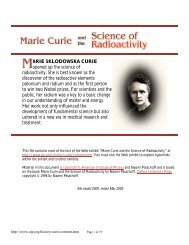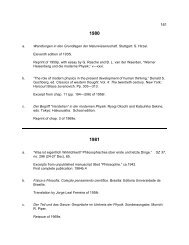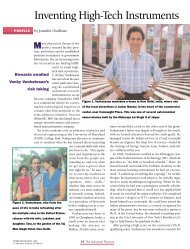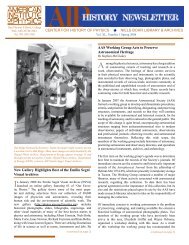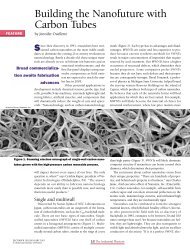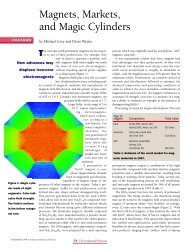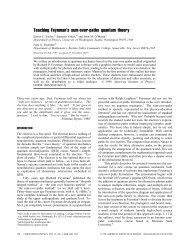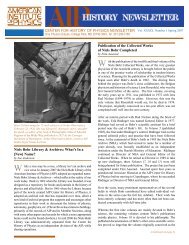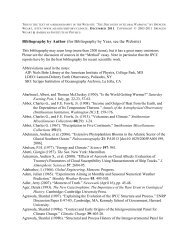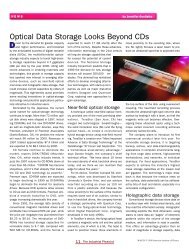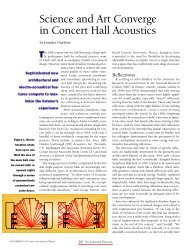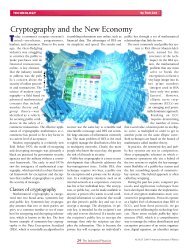AIPHISTORY NEWSLETTER - American Institute of Physics
AIPHISTORY NEWSLETTER - American Institute of Physics
AIPHISTORY NEWSLETTER - American Institute of Physics
You also want an ePaper? Increase the reach of your titles
YUMPU automatically turns print PDFs into web optimized ePapers that Google loves.
(Grants-in-Aid Serve Variety <strong>of</strong> Purposes, continued from page 1) archival materials I would not have had without the support <strong>of</strong><br />
the AlP History Center.<br />
that feedback be given once the grant has expired.... My particular<br />
grant was awarded for what was then very early-stage<br />
research on Felix Bloch’s ‘experimental turn’ upon emigrating to<br />
the US, and on one or two related issues in solid state physics<br />
between 1927 and the 1950’s. At the time the award was made, I<br />
was in the very earliest days <strong>of</strong> rethinking my trajectory, moving<br />
from a background strictly in philosophy and logic to work<br />
<strong>of</strong> a far more historical flavor.<br />
“... I did not use the full amount <strong>of</strong> my grant, but the part that I<br />
did use resulted firstly in a talk that was well received at two<br />
pr<strong>of</strong>essional conferences. More importantly, though, the upshot<br />
<strong>of</strong> my research on Bloch was to decide to pursue a PhD in<br />
the history <strong>of</strong> science... using my findings on Bloch as a writing<br />
sample ultimately helped me to secure a place at Harvard in Fall<br />
2002.<br />
“Since that time, the focus <strong>of</strong> my work has changed slightly (the<br />
dissertation project deals with the Sciences <strong>of</strong> Chaos and Complexity<br />
post 1960) but there are <strong>of</strong> course still substantial points<br />
<strong>of</strong> contact with solid state/condensed matter work.... This both<br />
required and will require a familiarity with basic concepts and<br />
APS Historic Sites Committee<br />
Designates Five Key <strong>Physics</strong> Sites<br />
by John S. Rigden<br />
T<br />
he Historic Sites Committee <strong>of</strong> the <strong>American</strong> Physical<br />
Society (see this Newsletter, Fall 2004, www.aip.org/<br />
history/newsletter/fall2004/historic-physics.htm) has selected<br />
the first five sites to be entered into to the APS Register<br />
<strong>of</strong> Historic Sites. These sites are the Franklin <strong>Institute</strong><br />
in Philadelphia in recognition <strong>of</strong> Benjamin Franklin’s pioneering<br />
work in electricity, The Johns Hopkins University<br />
where Henry Rowland revolutionized spectroscopy with<br />
his ruled gratings, Case-Western Reserve, the site <strong>of</strong> the<br />
Michelson-Morley experiment, Washington University in<br />
St. Louis where Arthur Compton did his famous X-ray scattering<br />
experiment, and Yale University where J. Willard<br />
Gibbs made fundamental contributions to thermodynamics.<br />
A plaque will be presented to each <strong>of</strong> these institutions.<br />
It will contain a brief citation followed by these words: “Historic<br />
<strong>Physics</strong> Site, Register <strong>of</strong> Historic Sites <strong>American</strong> Physical<br />
Society.” The first plaque was presented to the Franklin<br />
<strong>Institute</strong> on July 13, 2005.<br />
The members <strong>of</strong> the Historic Sites Committee are Gordon<br />
Baym, University <strong>of</strong> Illinois; Mildred Dresselhaus, MIT;<br />
Sidney Drell, Stanford; Gerald Holton, Harvard; and John<br />
Rigden, Washington University in St. Louis. The commit-<br />
2 ● History Newsletter Fall 2005<br />
“My work on Bloch... has unquestionably served as a springboard<br />
to places that back then seemed inconceivable... my warmest<br />
thanks for your support.”<br />
Our Grants-in-aid have not only helped launch careers, but are<br />
prized by postdoctoral students and both junior and senior<br />
historians from less-wealthy countries. For such scholars, a<br />
level <strong>of</strong> support that is small by most standards can make all the<br />
difference.<br />
In the November 2004 and May 2005 rounds, grants-in-aid<br />
were awarded to: Joseph Bassi for research on the solar-terrestrial<br />
(Sun-Earth) connection; Peter Bryne for research on Hugh<br />
Everett and his interpretation <strong>of</strong> quantum mechanics; Martha<br />
Harris for research on the chemical bond and the growth <strong>of</strong><br />
chemical physics in the 1920s and 30s; Arne Herndon & Thomas<br />
William for an oral history interview <strong>of</strong> Dorrit H<strong>of</strong>fleit; Maria<br />
V. Mokrova for research on Soviet-<strong>American</strong> contacts in physics,<br />
and Doogab Yi for research on biophysics and the discovery<br />
<strong>of</strong> DNA repair in postwar America — he has already sent us<br />
his oral history interviews with Richard B. Setlow and Harold J.<br />
Morowitz.<br />
Presenting the Historic <strong>Physics</strong> Site plaque at the Franklin<br />
<strong>Institute</strong>. L to R: John Rigden, Bo Hammer, Alan Chodos.<br />
tee expects to name additional sites later in 2005. A Web site<br />
is being developed which will give instructions for nominating<br />
sites for the APS Register and will feature those sites<br />
named to the register. The purpose <strong>of</strong> this APS initiative is to<br />
bring physics to the general public and raise awareness <strong>of</strong><br />
the importance <strong>of</strong> physics in the general culture.



